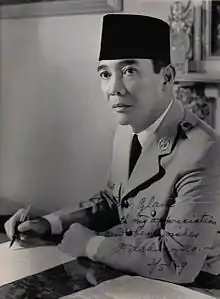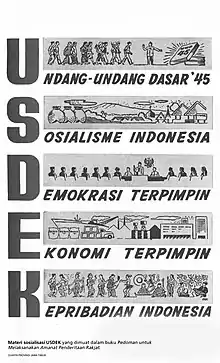Nasakom
Nasakom (which stands for nationalism, religion and communism; Indonesian: Nasionalisme, Agama, Komunisme) was a political concept coined by President Sukarno. This concept prevailed in Indonesia from 1959 during the Guided Democracy Era until the New Order, in 1966. Sukarno's idea of Nasakom was an attempt to unify various political ideologies.[1][2][3][4] Nasakom attempted to unite the nationalist, religious, and communist groups that at that time had the most power in Indonesian politics.
Development

Since the beginning of the struggle for Indonesian independence, there were three political movements that coloured the various movement organisations of the time. For example Indische Party and Sarekat Indies which were "nationalist", Sarekat Islam which had an Islamic ideology, and ISDV/PKI which had a Marxist ideology. The idea of Nasakom had actually been thought of by Sukarno since 1927, long before Indonesia's independence. Sukarno wrote a series of articles entitled "Nationalism, Islam and Marxism" in the magazine Soeloeh Indonesia Moeda,[5] a published publication of the "Algemeene Studieclub", the club Sukarno and his associates had founded in Bandung, inspired by a similar organization founded by Soetomo in Surabaya. The understanding of communism here was something more akin to socialism. The basis for this idea is the principle of social justice, which is also the basis of Karl Marx's political thought.[6] In the article, Sukarno stressed the importance of a national unity of nationalists, Islamists, Marxists in an uncompromising (non-cooperative) resistance to the Dutch.[7]
According to Sukarno:
"Nationalism, Islam, and Marxism, these are the principles that the people's movements throughout Asia have adhered to. These are the ideas that have become the spirit of the movements in Asia. They are also the spirit of the movements in Indonesia - our country."
— Sukarno, [7]
By 1956, Sukarno conveyed this idea. He publicly criticised the Parliamentary Democracy system, which he considered unsuitable for implementation in Indonesia. According to Sukarno, Parliamentary Democracy protects the capitalist system, and because the parliament is controlled by the bourgeoisie, this system cannot prosper the people.[8] In addition, Sukarno also considered that Parliamentary Democracy could endanger the government, stating that it was "based upon inherent conflict" which ran counter to Indonesian notions of harmony as being the natural state of human relationships. Instead, he sought a system based on the traditional village system of discussion and consensus (Gotong-Royong),[9] under the guidance of village elders. Therefore, in February 1956, Sukarno proposed a new concept called Nasakom based on three main pillars. The three pillars were Nationalism, Religion, and Communism.[10][9][11] These three pillars were intended to appease the three main factions in Indonesian politics — the army, Islamic groups, and the communists. With the support of the military, in February he proclaimed 'Guided Democracy', and proposed a cabinet that would represent all the political parties of importance (including the PKI).[12]
Implementation of Nasakom
In politics
After Nasakom was formed, Sukarno increasingly campaigned for his Nasakom concept. Sukarno united three political forces in order to strengthen his position. The three political parties that became the main factions in Indonesian politics at that time were:
- The nationalist Indonesian National Party (PNI).
- The religious Nahdlatul Ulama (NU)
- The communist Indonesian Communist Party (PKI).
Nasakom then grew the PKI in Indonesia and defeated the other parties. Sukarno gradually moved closer to the PKI and the Indonesian Air Force in an attempt to strengthen his position in competition with Nasakom. In March 1960, Sukarno dissolved Parliament after it rejected the budget.[13] In June, the Mutual Cooperation – People's Representative Council (Dewan Perwakilan Rakyat Gotong Royong, DPR-GR) and the Provisional People's Representative Council (MPRS) were established, with the armed services and police represented as functional groups, and PKI chairman D.N. Aidit as deputy chairman. The PKI is estimated to have occupied 17–25% of the seats in the DPR-GR and is now represented in all state bodies except the Cabinet.[14]: 256 Despite the warnings of Pro-PKI measures by regional military commanders, Sukarno repeatedly defended it.
Sukarno even campaigned for the Nasakom concept to international forums. He offered the principle of Pancasila's tolerance for world peace, which at that time was divided between the Western bloc and the Eastern bloc.[6] In the General Assembly of the United Nations (UN) on 30 September 1960 in New York, Sukarno delivered a speech entitled "To Build the World a New".[15] Through this speech, Sukarno conveyed the Nasakom concept that he made.[6] Furthermore, in the All-Indonesia Panca Tunggal Session at the State Palace, Jakarta, on 23 October 1965, Sukarno reiterated the importance of Nasakom even when his influence began to fade,[12][16]
" 'Ik ben nasionalist, ik ben islamiet, socialist. Tiga in one. Three in one, Soekarno.' The next time I was here, in front of the Merdeka Palace, I said: 'I am the feeling of Nasakom.' "
— Sukarno, [17]
Manipol/USDEK

In an attempt to unify the polarization of politics in Indonesia,[18][19] Soekarno created a manifesto, Manipol/USDEK, that was mandated to be taught in schools during the Guided Democracy Era. Manipol/USDEK is an acronym for Political Manifesto/1945 Constitution, Indonesian Socialism, Guided Democracy, Guided Economy, and Indonesian Personality (Indonesian: Manifesto Politik/Undang-Undang Dasar 1945, Sosialisme Indonesia, Demokrasi Terpimpin, Ekonomi Terpimpin, dan Kepribadian Indonesia).[20] Manipol/USDEK was inteded to serve as the foundation of the government. which the Provisional People's Consultative Assembly made into the State Policy Guidelines, so that they must be upheld, nurtured, and implemented by all Indonesians. The book consists of President Soekarno's speech titled "Rediscovery of Our Revolution," read on the 14th Independence Day of the Republic of Indonesia on 17 August 1959.
According to Sukarno, A book on Manipol/USDEK likens the Pancasila and the Political Manifesto/USDEK to the Quran and authentic Hadith, which are one in the same, so the Pancasila and the Political Manifesto/USDEK are also "one and the same".[21][22]
Failure of Nasakom
Sukarno was very keen to expand his Nasakom idea. However, no matter how hard he defended his Nakasom concept, this idea eventually ran aground.[23] The end of Nasakom was caused by the decline of the PKI's prestige due to the 30 September Movement. In addition, the end of Nasakom was also caused by the transition of power from the Old Order to the New Order, where Indonesia's new leader, Suharto, was strongly anti-communist. Thus, the idea of Nasakom came to an end.[12][10]
References
- Echols, John M.; Shadily, Hassan (1989), Kamus Indonesia Inggris: An Indonesian-English Dictionary (3 ed.), Jakarta: PT Gramedia, ISBN 979-403-756-7
- Friend, T. (2003). Indonesian Destinies. Harvard University Press. pp. 25, 82–83. ISBN 0-674-01137-6.
- Ricklefs, M. C. (1991). A History of Modern Indonesia since c. 1300 (2 ed.). MacMillan. p. 268. ISBN 0-333-57689-6. LCCN 94102636. OCLC 30320024. OL 1135607M. ISBN 0-333-57690-X. alternate version at Google Books with preview
- Vickers, Adrian (2005). A History of Modern Indonesia. Cambridge University Press. p. 146. ISBN 0-521-54262-6.
- Crawford, Oliver (20 July 2020). "Translating and Transliterating Marxism in Indonesia". Modern Asian Studies. 55 (3): 697–733. doi:10.1017/S0026749X20000104. ISSN 0026-749X.
- "Soekarno Yakin Pancasila Adalah Masa Depan Indonesia". dw.com (in Indonesian). 2016-06-21. Retrieved 2023-10-10.
- Ibrahim, Muhammad Ikbal A. (2016-06-12). "Sukarno dan Konsep Persatuan Nasakom - Berdikari Online" (in Indonesian). Retrieved 2023-10-10.
- Suleman, Zulfikri (2010). Demokrasi untuk Indonesia: pemikiran politik Bung Hatta (in Indonesian). Penerbit Buku Kompas. ISBN 978-979-709-484-3.
- Sukarno (1 June 1965). Nasakom adalah benar, amanat-indoktrinasi P.J.M. Presiden Sukarno pada pembukaan kursus kilat kader Nasakom (in Indonesian). Istora Bung Karno Senajan Djakarta: Dakarta Dewi Niaga.
{{cite book}}: CS1 maint: date and year (link) - Sidel, John T. (2021-05-15), "Soekarno and the Promise of Nasakom", Republicanism, Communism, Islam, Cornell University Press, pp. 146–168, retrieved 2023-10-10
- Pertjajalah pada benarnya Nasakom!; Amanat indoktrinasi Presiden Soekarno pada pembukaan kursus kilat kader Nasakom (in Indonesian). Djakarta: Pertjetakan Negara R.I. 1965.
- Adryamarthanino, Verelladevanka; Nada Nailufar, Nibras (2021-09-28). "Nasakom, Konsep Kesatuan Politik ala Soekarno Halaman all". KOMPAS.com (in Indonesian). Retrieved 2023-09-26.
- Cribb, Robert (2001). Yayasan API (Indonesia) (ed.). Parlemen Indonesia 1945-1959 (Indonesian Parliaments 1945-1959) in Panduan Parlemen Indonesia (Indonesian Parliamentary Guide) (Cet. 1 ed.). Jakarta: Yayasan API. ISBN 978-979-96532-1-5.
- Ricklefs 1982.
- "Pidato Soekarno Kini Jadi Milik Dunia". indonesia.go.id. 30 May 2023.
- Wibisono, Nuran. "Sejarah Nasakom: Upaya Sukarno Menyatukan Tiga Kekuatan Politik". tirto.id (in Indonesian). Retrieved 2023-10-10.
- Sukarno (1965) [23 October 1965 (Original writing)]. "Binalah Kesatuan dan Persatuan Nasional Progresif Revolusioner Atas Dasar Pantja Azimat Revolusi". Warta perdagangan (in Indonesian). Vol. 18 (Tri Dasawarsa ed.). Djakarta: Departemen Perdagangan Dalam Negeri. p. 9.
{{cite book}}: CS1 maint: date and year (link) - Sugiyono, Ahmad (2020). "Akar-Akar Demokrasi di Indonesia dan Perkembangannya Masa Kini": 12.
{{cite journal}}: Cite journal requires|journal=(help) - "Pendjelasan: manipol dan usdek". perpusbungkarno.perpusnas.go.id.
- Printono (1960). Manipol/Usdek. Dua-R. p. 78.
- Soekarno (1965). Djuhartono, Kangseng Gan (ed.). Wedjangan revolusi, karya Bung Karno. Sebuah kamus ilmu perdjuangan untuk rakjat, disusun menurut alfabet oleh sebuah team perangkai: Djuhartono [dan] Gan Kangseng. Jajasan Penjebar Pantja-Sila. p. 307.
- Nikolaev, Nikolai (1977). Indonesia - State and Politics (in Russian). Moscow: Nauka. p. 112.
- Mu'alimin, Muhammad; Alum, Reko (6 February 2018). "Cinta Buya Ismail kepada HMI". www.law-justice.co. Law & Justice. Retrieved 5 July 2019.